The Internal Socio-Economic Polarization of Urban Neighborhoods: The Case of the Municipality of Nice
Abstract
:1. Introduction
1.1. Urban Social Segregation: An Extensive Term to Characterize the Urban Space
1.2. Internal Social Polarization of French Urban Spaces
The Different Manifestations of the Geographical Coexistence of Social Groups in City Centers: Between Life Course Transitions and Spatial Transformations
1.3. The Context of Nice
1.3.1. Demographic Diversity Within the Nice Côte d’Azur Metropolitan Area: Relative Population Stagnation in Nice and Demographic Dynamism in the Suburbs and Hinterland
1.3.2. Relative Concentration of Seniors and a Slight Deficit of Young Adults
1.3.3. Touristification of the Residential Space in Nice: A Trend Towards Secondary Residences with High Housing Vacancy
2. Materials and Methods
3. Results
3.1. A City with Pronounced Polarization at Its Core
3.2. Neighborhoods of the Municipality of Nice with Pronounced Internal Socio-Economic Polarization
- The proportion of flats belonging to buildings completed before 1945;
- The proportion of secondary and occasional residences;
- The proportion of households renting in social housing;
- The proportion of employed people walking to work.
3.3. Internal Socio-Economic Polarization and the Gentrification Process
4. Discussion
5. Conclusions
Funding
Institutional Review Board Statement
Informed Consent Statement
Data Availability Statement
Conflicts of Interest
| 1 | The comparable territories selected are municipalities with populations ranging from 200,000 to 500,000 inhabitants in 2017. These include the municipalities of Lille, Rennes, Bordeaux, Toulouse, Nantes, Strasbourg, and Montpellier. |
| 2 | Aggregated units for statistical information (IRIS) are a set of contiguous units populated by approximately 2000 inhabitants (the least populated IRISs have 1800 inhabitants and the most populated have 5000 inhabitants). |
| 3 | Some households file their tax returns in the department where their secondary residence is located. |
| 4 | Cramér’s V is a measure of correlation between two qualitative variables. In the absence of correlation, Cramér’s V is 0, and, in the case of absolute correlation, it is 1. Generally, a Cramér’s V below 0.1 indicates a very weak correlation, while a Cramér’s V above 0.3 indicates a strong correlation. |
| 5 | For reasons of statistical validity and data interpretation, only the residential IRIS of municipalities with at least 10,000 inhabitants, for which INSEE does not mention any particular caution, are included in the analysis. Activity IRIS are not considered as they do not correspond to the objective of this analysis. |
| 6 | In all the results presented in Section 3, any overrepresentations or under-representations observed for certain categories of populations or housing refer to other IRIS in the municipality of Nice (the PCA results) or to the average of the entire municipality (the results of the trend analysis of the poverty and wealth indexes between 2012 and 2017). |
| 7 | Clearly, the vacancy rate is only an indirect and imperfect indicator of the effect of the poor quality of part of the housing stock on the presence of low-income populations, since, by definition, these populations do not occupy vacant dwellings. Furthermore, in the context of the touristification of these IRISs, reflected in the high proportion of second homes, it is not impossible that some of the vacant dwellings are in fact dwellings intended for occasional rental. |
| 8 | With respect to the current state of the available data, only the age of buildings containing secondary or occasional residences can be known at the scale of entire municipalities via the detailed “housing” file from the updated population census. |
References
- Arrighi, Jean-Jacques. 2018. Depuis 25 ans, 30,000 Logements Supplémentaires Chaque Année. INSEE Flash Provence-Alpes-Côte d’Azur. Available online: https://www.insee.fr/fr/statistiques/3570775 (accessed on 2 February 2021).
- Audren, Gwenaëlle, Virginie Baby-Collin, and Elisabeth Dorier. 2016. Quelles mixités dans une ville fragmentée? Dynamiques locales de l’espace scolaire marseillais. Lien social et Politiques 77: 38–61. [Google Scholar] [CrossRef]
- Authier, Jean-Yves. 1995. Formes et processus de ségrégation dans les quartiers anciens centraux réhabilités. L’exemple du quartier Saint-Georges à Lyon. Sociétés Contemporaines 22–23: 107–25. [Google Scholar] [CrossRef]
- Authier, Jean-Yves. 2003. La gentrification du quartier Saint-Georges à Lyon, un côtoiement des mobilités différenciées. In Retours en ville: Des processus de «gentrification» urbaine aux politiques de «revitalisation» des centres. Edited by Catherine Bidou-Zachariasen, Daniel Hiernaux-Nicolas and Hélène Rivière d’Arc. Paris: Descartes et Cie, pp. 105–26. [Google Scholar]
- Authier, Jean-Yves, and Sonia Lehman-Frisch. 2013. La mixité dans les quartiers gentrifiés: Un jen d’enfants. Métropolitiques. Available online: https://metropolitiques.eu/La-mixite-dans-les-quartiers-gentrifies-un-jeu-d-enfants.html (accessed on 3 May 2019).
- Bacqué, Marie-Hélène, and Yankel Fijalkow. 2006. En attendant la gentrification: Discours et politiques à la Goutte d’Or (1982–2000). Sociétés Contemporaines 3: 63–83. [Google Scholar] [CrossRef]
- Bourdin, Alain. 2008. Gentrification: Un «concept» à déconstruire. Espaces et sociétés 1–2: 23–37. [Google Scholar] [CrossRef]
- Bourne, Larry Stuart. 1993. The Myth and Reality of Gentrification: A Commentary on Emerging Urban Forms. Urban Studies 1: 183–89. [Google Scholar] [CrossRef]
- Bouzouina, Louafi. 2007. Concentrations spatiales des populations à faible revenu, entre polarisation et mixité. Une analyse de trois grandes aires urbaines françaises. Pensée Plurielle 3: 59–72. [Google Scholar] [CrossRef]
- Bouzouina, Louafi. 2008. Ségrégation Sociale et Dynamiques Métropolitaines. Ph.D. thesis, Université Lumière-Lyon II, Lyon, France. [Google Scholar]
- Bozon, Michel. 1984. Vie quotidienne et rapports sociaux dans une petite ville de province. La mise en scène des différences. Lyon: Presses Universitaires de Lyon. [Google Scholar]
- Bridge, Gary. 2006. It’s not Just a Question of Taste: Gentrification, the Neighbourhood, and Cultural Capital. Environment and Planning A: Economy and Space 10: 1965–78. [Google Scholar] [CrossRef]
- Brueckner, Jan, Jacques-François Thisse, and Yves Zenou. 1999. Why is central Paris rich and downtown Detroit poor? An amenity-based theory. Européen Economic Review 12: 91–107. [Google Scholar] [CrossRef]
- Brun, Jacques. 1994. Essai critique sur la notion de ségrégation et sur son usage en géographie urbaine. In La ségrégation dans la ville. Edited by Jacques Brun and Catherine Rhein. Paris: L’Harmattan, pp. 21–57. [Google Scholar]
- Centi, César. 1993. Les enjeux du modèle niçois. L’approche localiste du développement en question. Revue économique 4: 685–712. [Google Scholar] [CrossRef]
- Chabrol, Marie, and Lydie Launay. 2016. Résider dans un quartier en gentrification. L’importance des trajectoires et des mobilités. In Gentrifications. Edited by Marie Chabrol, Anaïs Collet, Mathieu Giroud, Lydie Launay, Max Rousseau and Hovig Ter Minassian. Paris: Editions Amsterdam, pp. 305–24. [Google Scholar]
- Chamboredon, Jean-Claude, and Madeleine Lemaire. 1970. Proximité spatiale et distance sociale. Les grands ensembles et leur peuplement. Revue française de sociologie 1: 3–33. [Google Scholar] [CrossRef]
- Chauvot, Nicolas, and Jacques Pougnard. 2014. «Métropole Nice Côte d’azur Une croissance démographique à retrouver», Insee Analyses Provence-Alpes-Côte d’Azur 7. Available online: https://www.insee.fr/fr/statistiques/1285761 (accessed on 5 May 2019).
- Christofle, Sylvie, and Christian Hélion. 2018. Territoire(s), touriste(s) et habitants à Nice Côte-d’Azur Métropole. In Le touriste et l’habitant. Edited by Dominique Crozat and Daiane Alves. Saint-Denis: Connaissances et Savoirs, coll. Patrimoine et Tourisme. [Google Scholar]
- Collet, Anaïs. 2015. Rester bourgeois. Les quartiers populaires, nouveaux chantiers de la distinction. Paris: La Découverte. [Google Scholar]
- Conseil Communautaire. 2010. Plan local d’Urbanisme Nice ville verte de la Méditerranée: Rapport de présentation-Diagnostic. Nice: DGAALM—Direction Aménagement et Urbanisme. [Google Scholar]
- Decamps, Aurélien. 2009. Effets de quartiers et dynamique de la ségrégation urbaine. Ph.D. thesis, Université Montesquieu-Bordeaux IV, Bordeaux, France. [Google Scholar]
- Decoupigny, Fabrice, Christine Voiron-Canicio, Giovanni Fusco, and Marie Sevenet. 2007. Analyse de la pression urbaine exercée sur les Alpes-Maritimes. Rapport d’étude pour le PREDAT 06, UMR ESPACE. Nice: Université de Nice-Sophia Antipoli. [Google Scholar]
- DREAL Provence-Alpes Côte d’Azur. 2018. Atlas régional de l’habitat en Provence-Alpes-Côte d’Azur. Available online: https://www.paca.developpement-durable.gouv.fr/atlas-regional-de-l-habitat-2018-en-paca-a11837.html (accessed on 15 July 2020).
- Frantz, David. 2010. Migrations et division sociale de l’espace en toscane: Structures et dynamiques. Ph.D. thesis, Université de Caen Basse-Normandie, Caen, France. [Google Scholar]
- Fusco, Giovanni, and Floriane Scarella. 2008a. L’évolution de l’habitat dans les Alpes-Maritimes et dans l’Est-Var, Eléments d’analyse pour un scénario de développement tendanciel. Rapport d’étude pour le PREDAT Alpes-Maritimes. Nice: UMR Espace. [Google Scholar]
- Fusco, Giovanni, and Floriane Scarella. 2008b. Les évolutions de l’habitat dans l’espace azuréen. Analyse des logiques spatiales dans un contexte métropolitain méditerranéen. Paper presented at XLVè Colloque de l’ASRDLF, Rimouski, QC, Canada, August 25–27. [Google Scholar]
- Fusco, Giovanni, and Floriane Scarella. 2011. Métropolisation et ségrégation socio-spatiale: Les flux de mobilités résidentielles en Provence-Alpes-Côte d’Azur. L’Espace géographique 4: 319–36. [Google Scholar] [CrossRef]
- Giraud, Colin. 2010. Identités et espaces homosexuels: Le bas des pentes de la Croix-Rousse à Lyon. In Homosexualités: Révélateur social? Edited by Christophe Bareille. Mont-Saint-Aignan: Presses universitaires de Rouen et du Havre, pp. 133–41. [Google Scholar]
- Giroud, Mathieu. 2015. Mixité, contrôle social et gentrification. La Vie des idées. Available online: www.laviedesidees.fr/Mixite-controle-social-et-gentrification.html (accessed on 15 June 2020).
- Giroud, Mathieu, and Hovig Ter Minassian. 2016. Gentrification, paupérisation, immigration. Un processus peut en cacher un autre. In Gentrifications. Edited by Marie Cabrol, Anaïs Collet, Mathieu Giroud, Lydie Launay, Max Rousseau and Hovig Ter Minassian. Paris: Editions Amsterdam, pp. 261–81. [Google Scholar]
- Gotham, Kevin Fox. 2005. Tourism gentrification: The case of New Orleans’ vieux carré (French Quarter). Urban Studies 7: 1099–121. [Google Scholar] [CrossRef]
- Goujard, Antoine. 2002. Résidences secondaires des étrangers et territoire français: Localisation et retombées économiques locales, la valorisation d’un capital symbolique. Créteil: Mémoire de DEA, Institut d’Urbanisme de Paris, Université Paris-Val-de-Marne. [Google Scholar]
- Grafmeyer, Yves. 1992. Quand le Tout-Lyon se compte. Lignées, alliances, territoires. Lyon: Presses Universitaires de Lyon, coll. Tranversales. [Google Scholar]
- Grafmeyer, Yves. 1994. Regards sociologiques sur la ségrégation. In La ségrégation dans la ville. Edited by Jacques Brun and Catherine Rhein. Paris: L’Harmattan, pp. 85–117. [Google Scholar]
- Grafmeyer, Yves, and Jean-Yves Authier. 2019. Pour la sociologie urbaine. Lyon: Presses Universitaires de Lyon. [Google Scholar]
- Gripsiou, Argyro, and Christophe Bergouignan. 2022. La polarisation socio-économique interne des quartiers centraux des métropoles françaises de province. Espace populations société, 2–3. [Google Scholar] [CrossRef]
- INSEE. 2014. «Portait Infra-communal de la Métropole Nice Côte d’Azur», Chiffres Détaillés. Available online: https://www.insee.fr/fr/statistiques/2384968?sommaire=2384335 (accessed on 17 September 2021).
- INSEE. 2020. Evolution et structure de la population en 2017, Intercommunalité-Métropole de Métropole Nice Côte d’Azur (200030195). Available online: https://www.insee.fr/fr/statistiques/4515315?sommaire=4515349&geo=EPCI-200030195 (accessed on 17 September 2021).
- Jeanmougin, Hélène, and Florence Bouillon. 2016. D’une gentrification inaboutie à une «nouvelle précarisation»? Continuités populaires et conflits de coprésence dans le centre historique de Palerme. Lien social et Politiques 77: 103–25. [Google Scholar] [CrossRef]
- Jourdan, Silvère. 2008. Un cas aporétique de gentrification: La ville de Marseille. Méditerranée 111: 85–90. [Google Scholar] [CrossRef]
- Launay, Lydie. 2016. Négocier la diversité au quotidien. Des rapports de voisinage et des choix scolaires sous contrôle. In Gentrifications. Edited by Marie Chabrol, Anais Collet, Mathieu Giroud, Lydie Launay, Max Rousseau and Hovig Ter Minassian. Paris: Editions Amsterdam, pp. 325–43. [Google Scholar]
- Lehman-Frisch, Sonia. 2003. La Mission, barrio de San Francisco: L’hispanisation d’un quartier américan et de sa rue commerçante. Espace, population, sociétés 1: 117–35. [Google Scholar] [CrossRef]
- Lehman-Frisch, Sonia. 2008. «Gentrifieurs, gentrifiés»: Cohabiter dans le quartier de la Mission (San Francisco). Espaces et sociétés 1–2: 143–60. [Google Scholar] [CrossRef]
- Lehman-Frisch, Sonia. 2009. La ségrégation: Une injustice spatiale? Questions de recherche. Annales de géographie 665–66: 94–115. [Google Scholar] [CrossRef]
- Lenel, Emmanuelle. 2011. «Un regard phénoménologique sur la mixité urbaine». Espaces Temps 1: 15. Available online: http://hdl.handle.net/2078.3/152777 (accessed on 1 January 2019).
- Lopez-Gay, Antonio, Augustin Cocola-Gant, and Antonio Paolo Russo. 2021. Urban tourism and population change:Gentrification in the age of mobilities. Population Space Place 27: e2380. [Google Scholar] [CrossRef]
- Madoré, François. 2015. Approche comparative de la ségrégation socio-spatiale dans les aires urbaines françaises. Annales de géographie 706: 653–80. [Google Scholar] [CrossRef]
- Maloutas, Thomas, and Stavros Nikiforos Spyrellis. 2019. Segregation trends in Athens: The changing residential distribution of occupational categories during the 2000s. Regional Studies 4: 462–71. [Google Scholar] [CrossRef]
- Maurin, Eric. 2004. Le ghetto français. Enquête sur le séparatisme social. Paris: Seuil. [Google Scholar]
- Métropole Nice Côte d’Azur. 2016a. Plan local d’Urbanisme Métropolitain- Diagnostic territorial. Nice: Métropole Nice Côte d’Azur. [Google Scholar]
- Métropole Nice Côte d’Azur. 2016b. Programme Local de L’habitat 2017/2022 Bilan PLH 2010–2015. Nice: Métropole Nice Côte d’Azur. [Google Scholar]
- Métropole Nice Côte d’Azur. 2023. Plan local d’urbanisme Métropolitain: Révision Générale no1. Concertation Publique Phase 1, Premiers éléments de diagnostic territorial et de PADD. Available online: https://www.nicecotedazur.org/services/urbanisme/plum/revision-generale-du-plum/ (accessed on 12 April 2021).
- Oberti, Marco, and Edmond Préteceille. 2016. La ségrégation urbaine. Paris: La Découverte. [Google Scholar]
- Park, Robert Ezra. 2004. La communauté urbaine: Un modèle spatial et un ordre moral [1926]. In L’Ecole de Chicago: Naissance de l’écologie urbaine. Edited by Yves Grafmeyer and Isaac Joseph. Malkesherbes: Champs essais, pp. 197–211. [Google Scholar]
- Pinçon, Michel, and Monique Pinçon-Charlot. 1989. Dans les beaux quartiers. Paris: Seuil. [Google Scholar]
- Pinçon, Michel, and Monique Pinçon-Charlot. 2014. Sociologie de Paris. Paris: La Découverte. [Google Scholar]
- Préteceille, Edmond. 1995. Ségrégations urbaines. Société contemporaines 22–23: 5–14. [Google Scholar] [CrossRef]
- Préteceille, Edmond. 2006a. La ségrégation sociale a-t-elle augmenté: La métropole parisienne entre polarisation et mixité. Sociétés contemporaine 2: 69–93. [Google Scholar] [CrossRef]
- Préteceille, Edmond. 2006b. La ségrégation contre la cohésion sociale: La métropole parisienne. In L’épreuve des inégalités. Edited by Hugues Lagrange. Paris: Presses Universitaires de France, pp. 195–246. [Google Scholar]
- Roncayolo, Marcel. 1994. Préface. In La ségrégation dans la ville. Edited by Jacques Brun and Catherine Rhein. Paris: L’Harmattan, pp. 13–17. [Google Scholar]
- Roncayolo, Marcel. 2001. La ville et ses territoires. Paris: Gallimard Folio. [Google Scholar]
- Scarella, Floriane. 2014. La ségrégation résidentielle en contexte métropolitain: Analyse spatiale et géoprospective des dynamiques résidentielles en région PACA. Ph.D. thesis, Université Nice Sophia Antipolis, Nice, France. [Google Scholar]
- Schwabe, Markus. 2007. La ségrégation résidentielle dans les plus grandes villes françaises (1968–1999): Quel modèle urbain? Cybergeo. [Google Scholar] [CrossRef]
- Simon, Patrick. 1995. La société partagée. Relations interethniques et interclasses dans un quartier en rénovation. Belleville, Paris XX e. Cahiers internationaux de sociologie 48: 161–90. [Google Scholar]
- Simon, Patrick. 1997. Les usages sociaux de la rue dans un quartier cosmopolite. Espaces et sociétés 2: 43–68. [Google Scholar] [CrossRef]
- Ter Minassian, Hovig. 2009. Ciutat Vella entre réhabilitation et gentrification. Politiques publiques et changements sociaux dans le centre ancien de Barcelone (1980–2008). Ph.D. thesis, Université de Paris 1 Panthéon-Sorbonne, Universitat de Barcelona, Barcelona, Spain. [Google Scholar]
- Tissot, Sylvie. 2010. Quand la mixité sociale mobilise des gentrifieurs. Enquête sur un mot d’ordre militant à Boston. Espaces et sociétés 1–2: 127–42. [Google Scholar] [CrossRef]
- Tissot, Sylvie. 2011. De bons voisins. Enquête dans un quartier de la bourgeoisie progressiste. Paris: Raison d’agir. [Google Scholar]
- Van Criekingen, Mathieu, and Jean Michel Decroly. 2003. Revisiting the diversity of gentrification: Neighbourhood renewal processes in Brussels and Montreal. Urban Studies 12: 2451–68. [Google Scholar] [CrossRef]
- Van Zanten, Agnès. 2009. Choisir son école. Stratégies familiales et médiations locales. Paris: Presses Universitaires de France. [Google Scholar] [CrossRef]
- Zalio, Pierre Paul. 1999. Grandes familles de Marseille au XXe siècle. Paris: Belin. [Google Scholar]
- Zukin, Sharon. 1998. Urban lifestyles: Diversity and standardisation in spaces of consumption. Urban Studies 5–6: 825–39. [Google Scholar] [CrossRef]
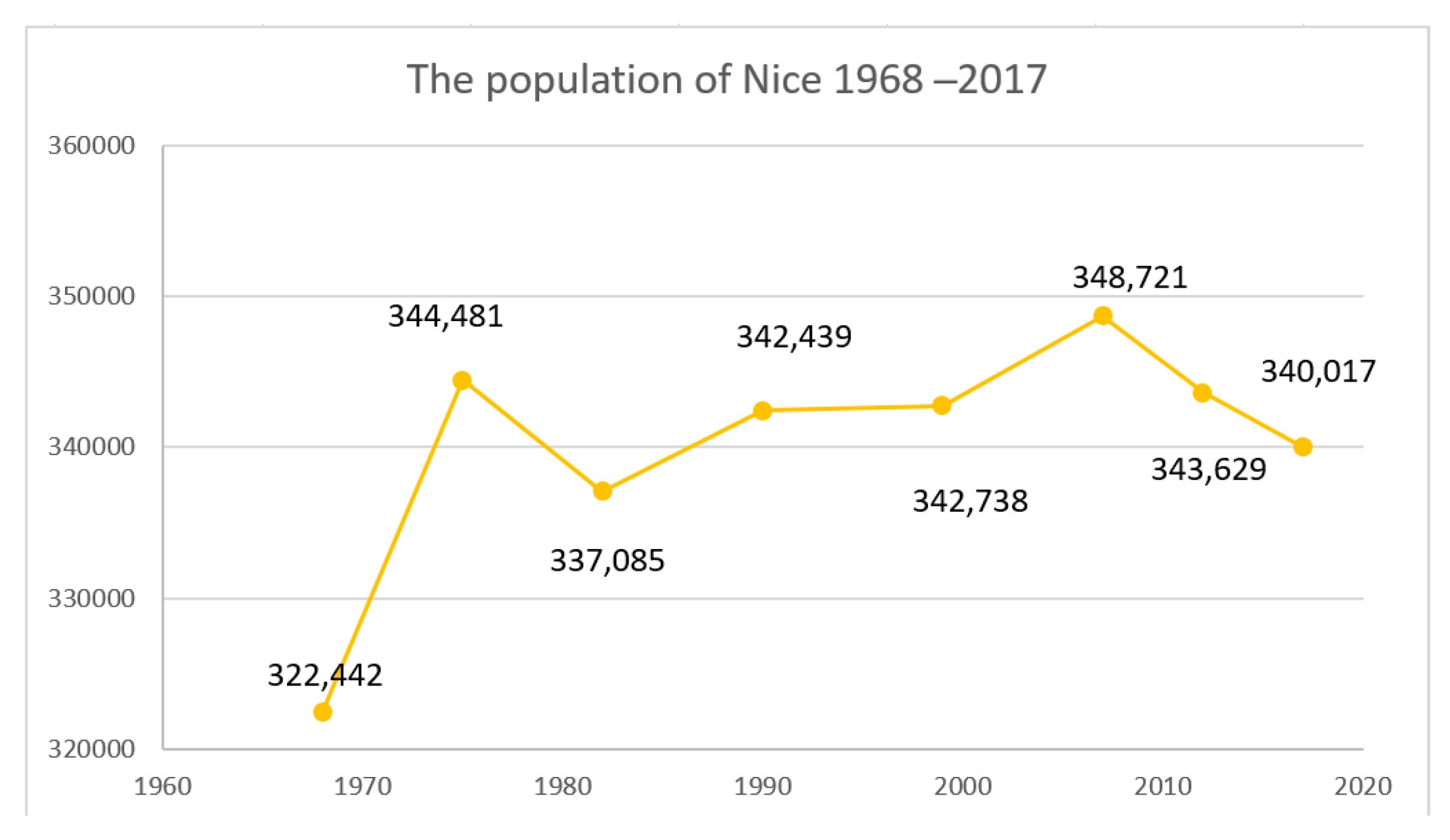
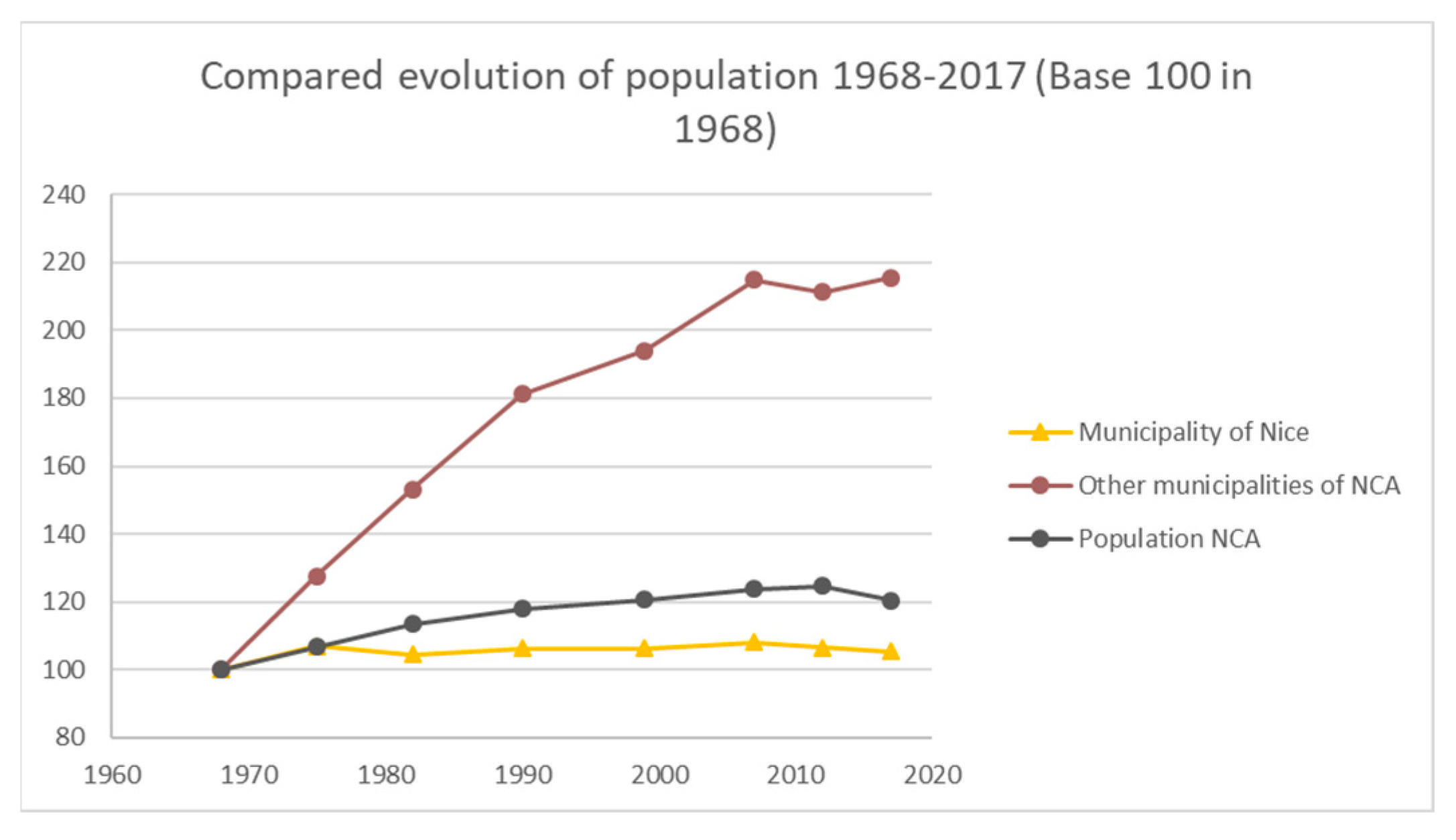
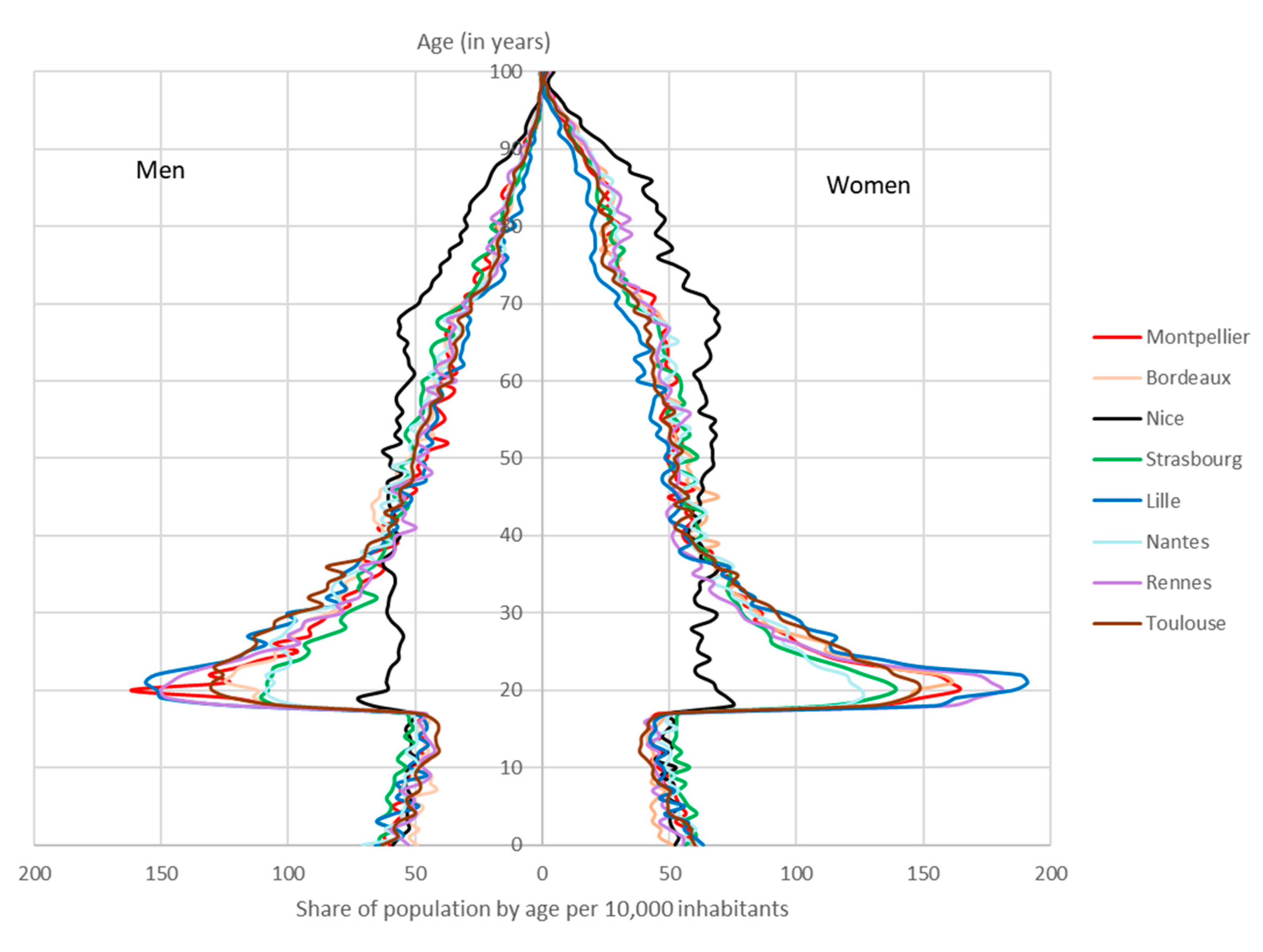
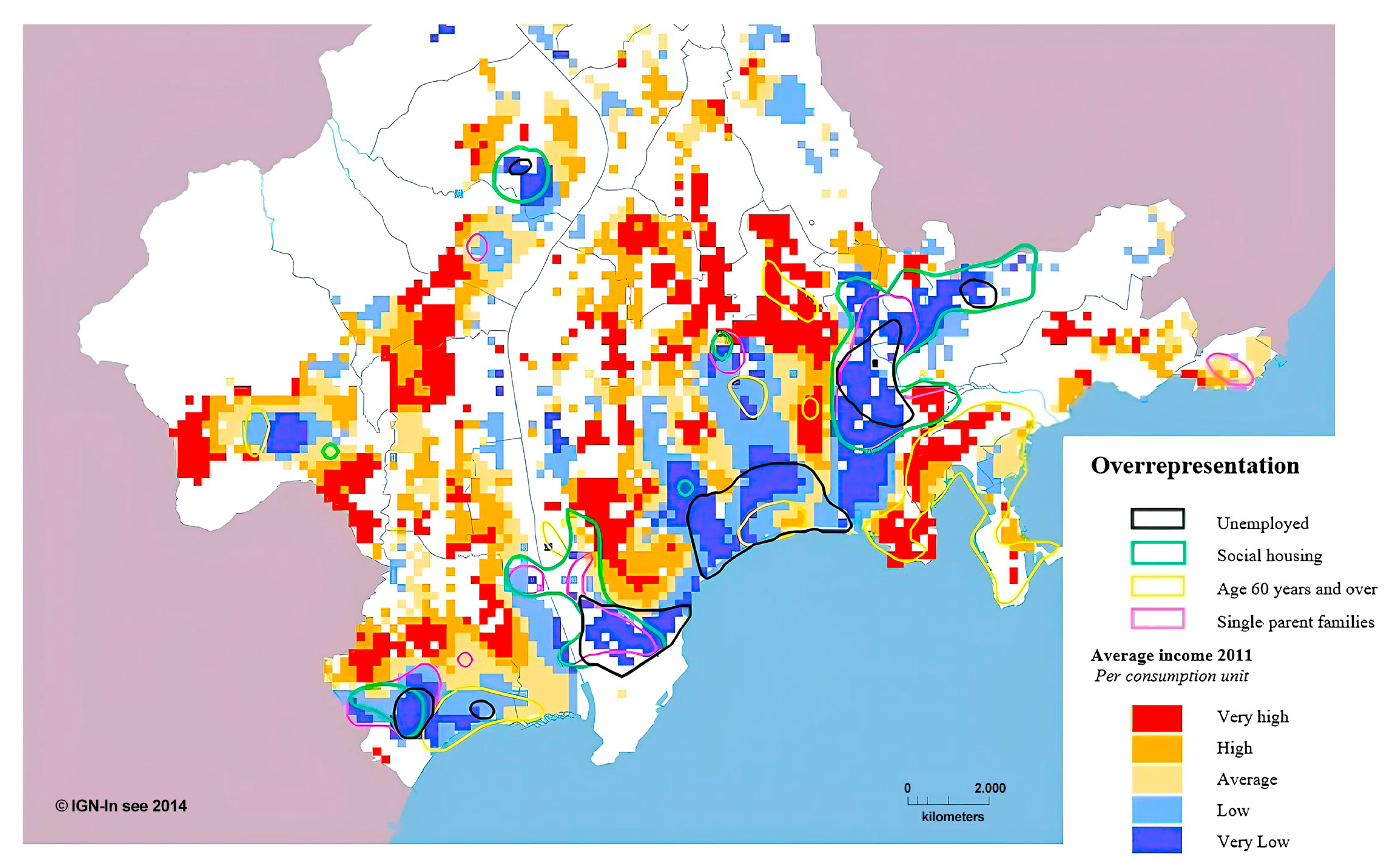
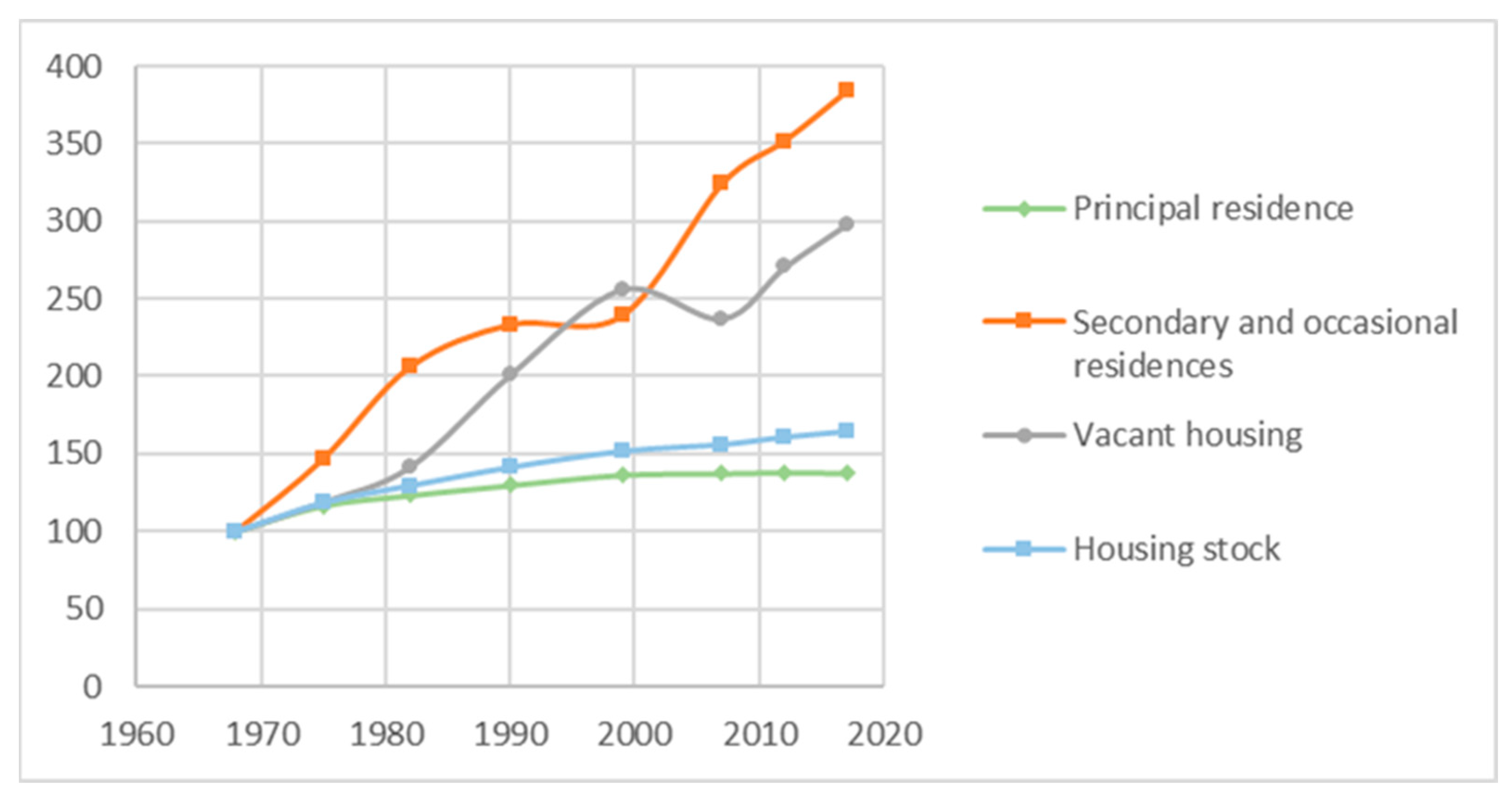
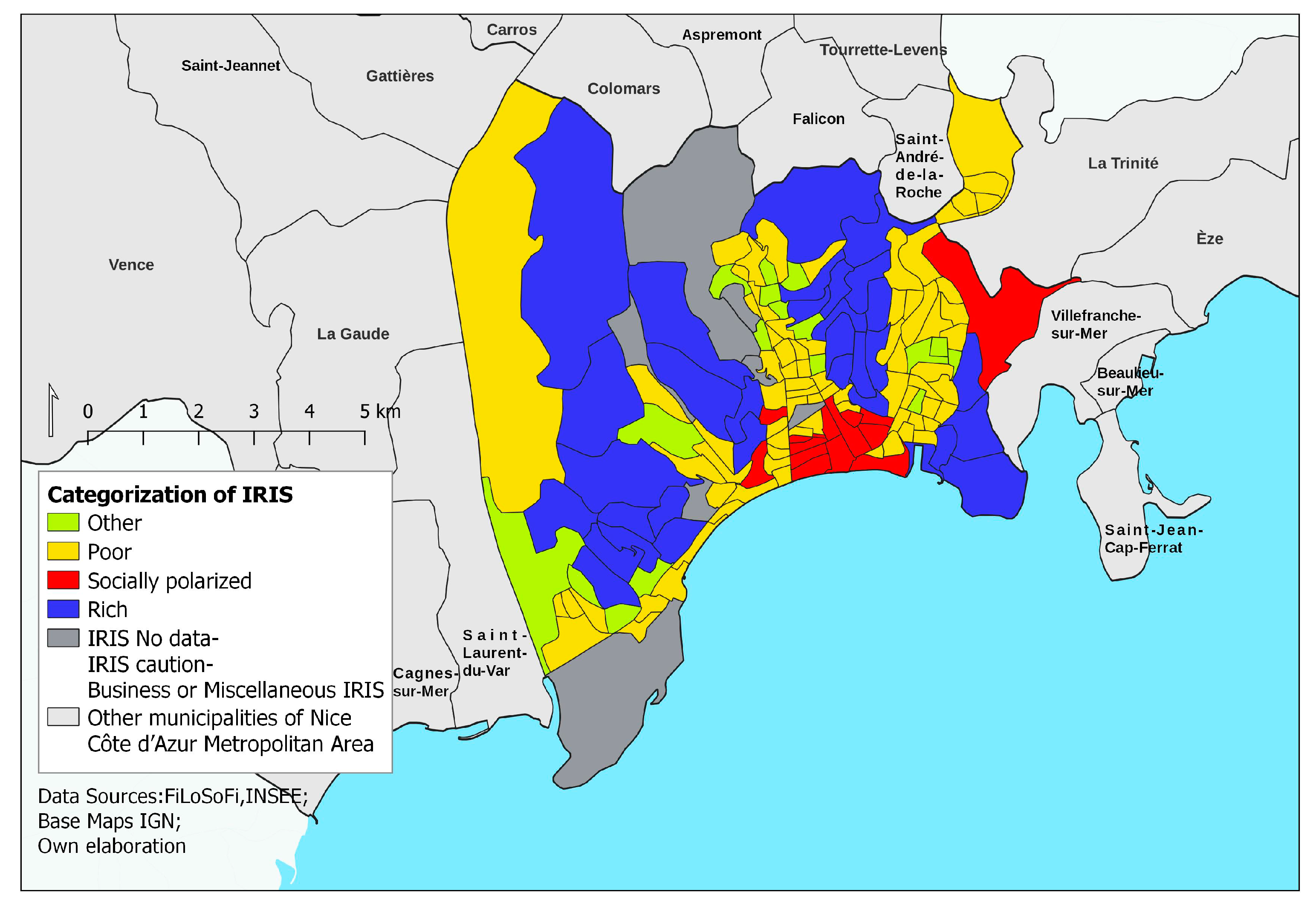
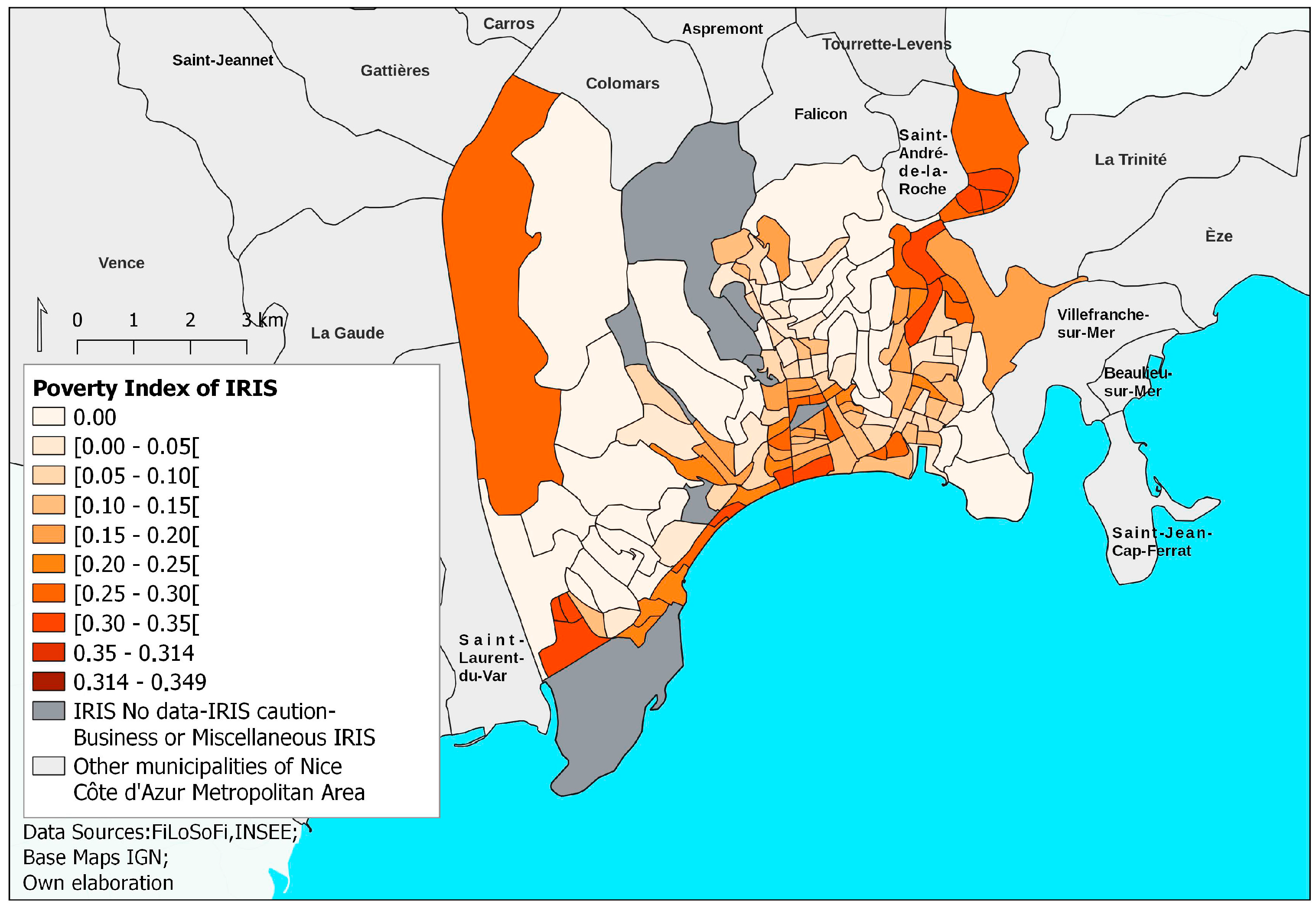

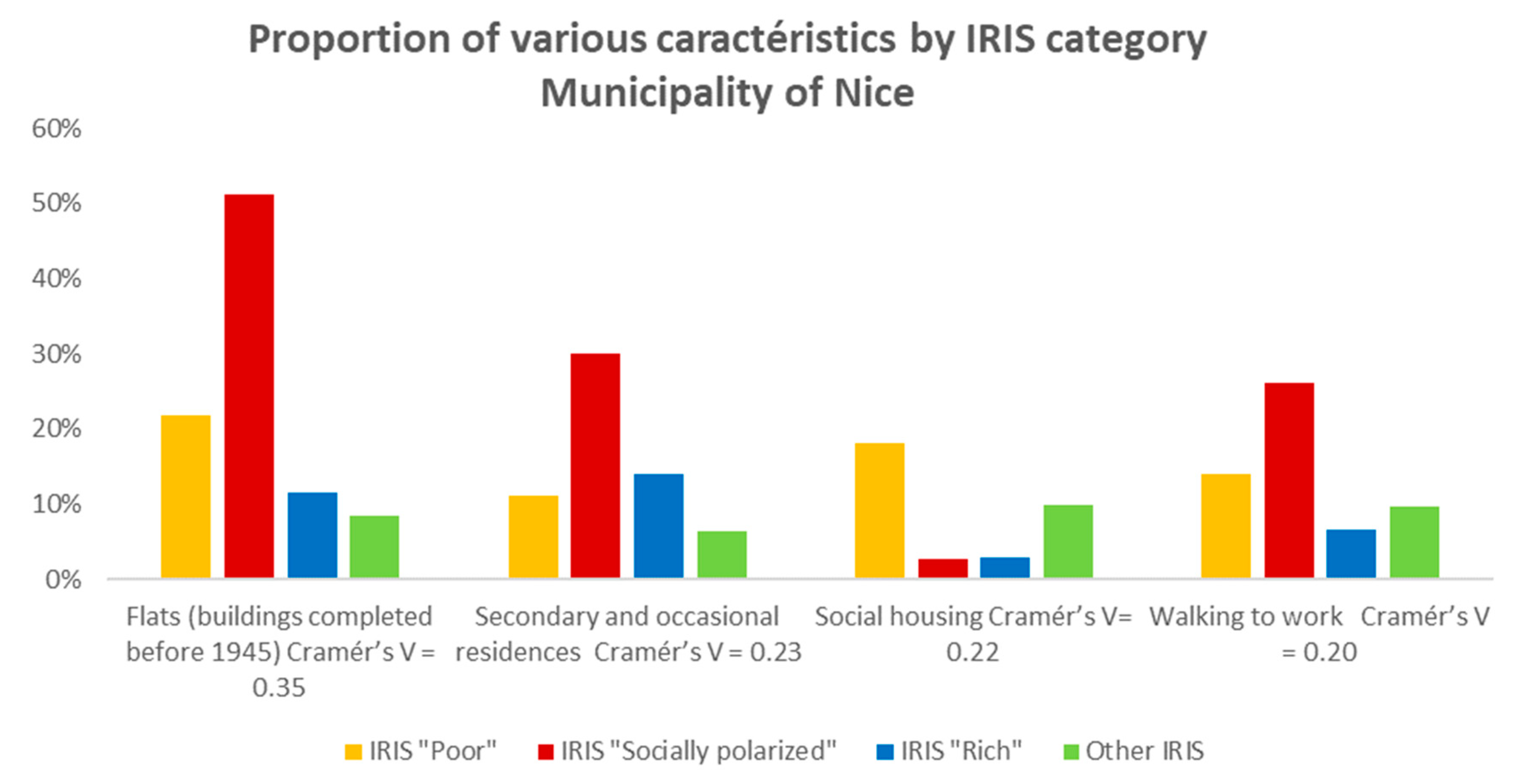

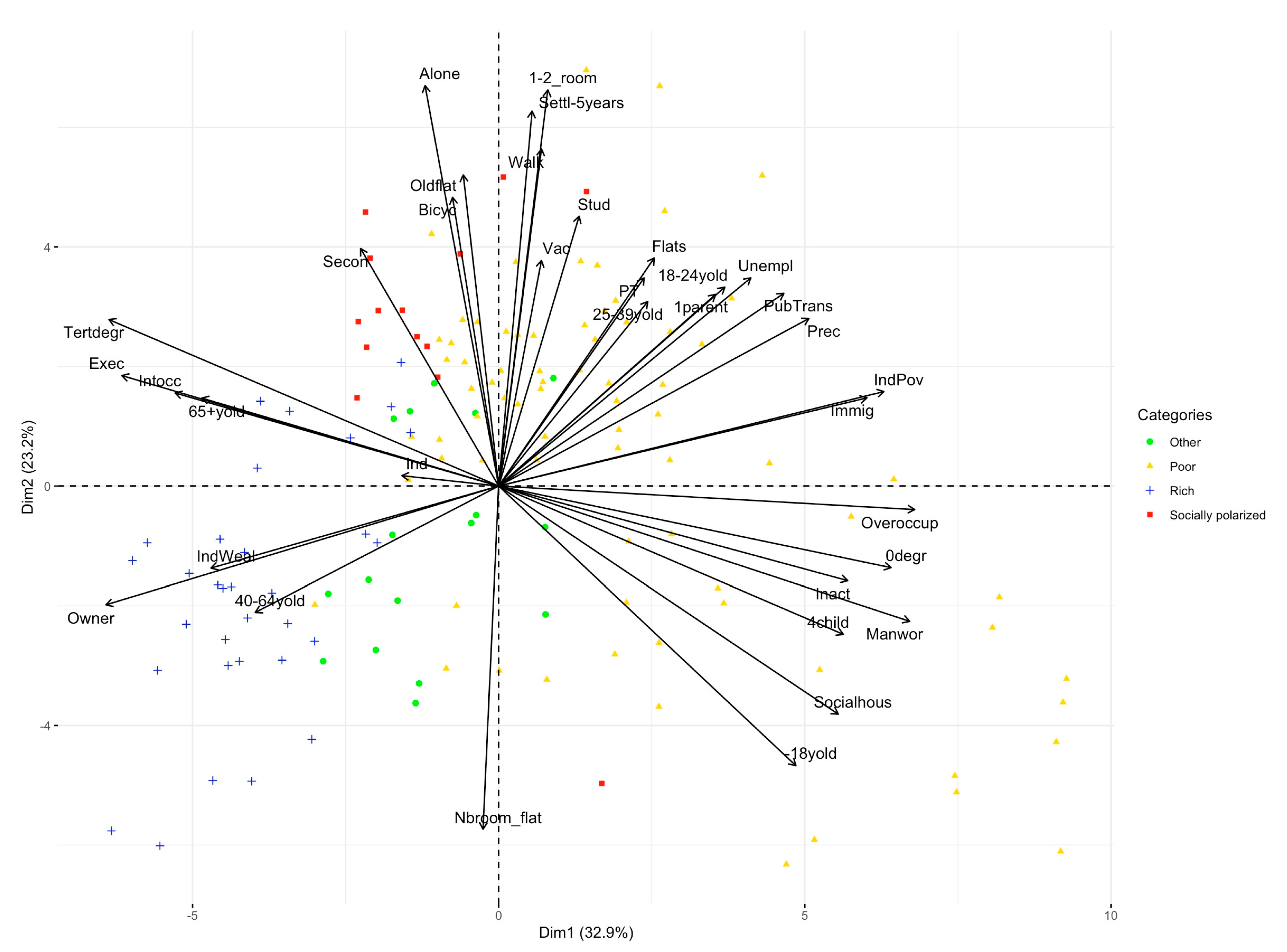
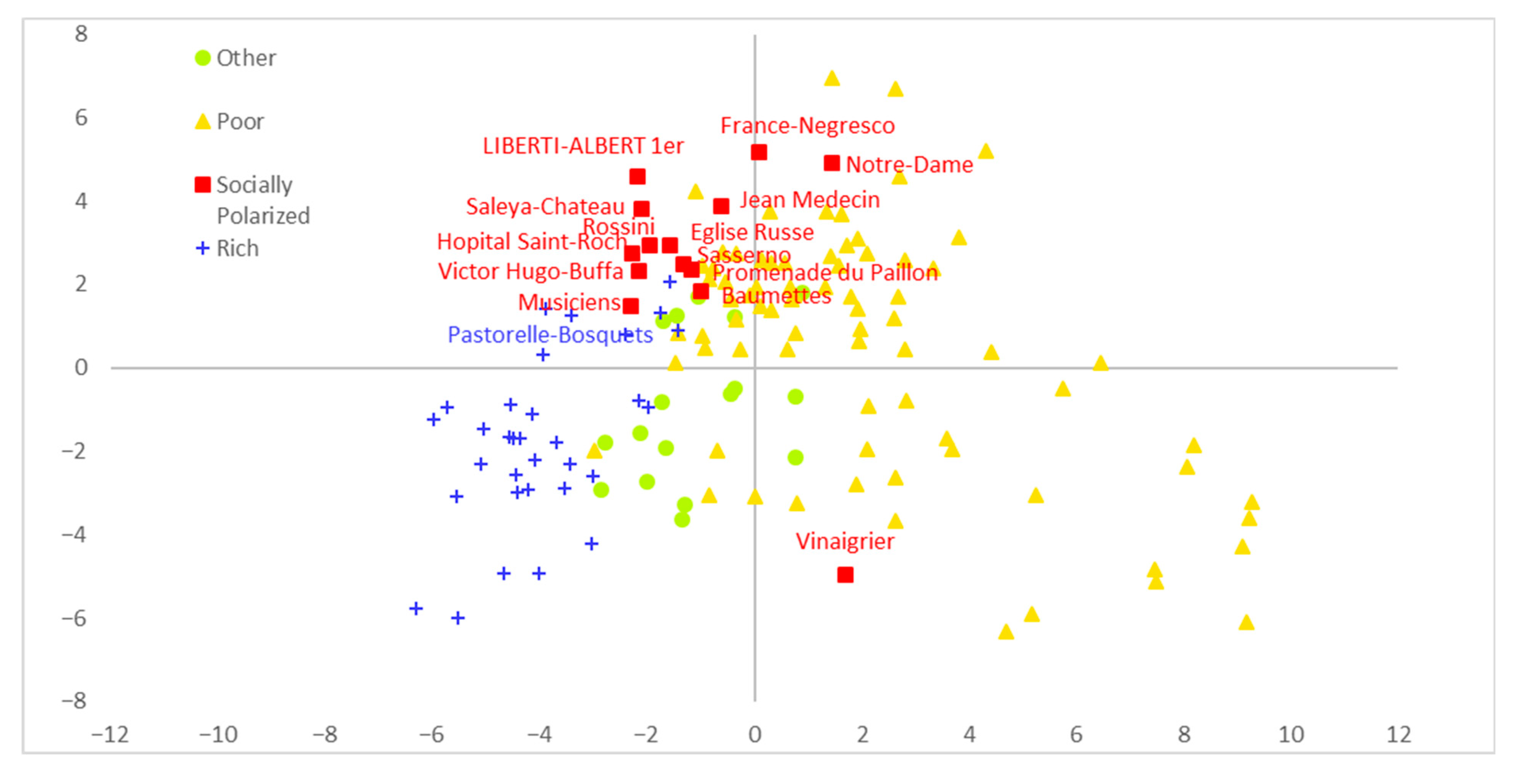
Disclaimer/Publisher’s Note: The statements, opinions and data contained in all publications are solely those of the individual author(s) and contributor(s) and not of MDPI and/or the editor(s). MDPI and/or the editor(s) disclaim responsibility for any injury to people or property resulting from any ideas, methods, instructions or products referred to in the content. |
© 2024 by the author. Licensee MDPI, Basel, Switzerland. This article is an open access article distributed under the terms and conditions of the Creative Commons Attribution (CC BY) license (https://creativecommons.org/licenses/by/4.0/).
Share and Cite
Gripsiou, A. The Internal Socio-Economic Polarization of Urban Neighborhoods: The Case of the Municipality of Nice. Soc. Sci. 2024, 13, 559. https://doi.org/10.3390/socsci13100559
Gripsiou A. The Internal Socio-Economic Polarization of Urban Neighborhoods: The Case of the Municipality of Nice. Social Sciences. 2024; 13(10):559. https://doi.org/10.3390/socsci13100559
Chicago/Turabian StyleGripsiou, Argyro. 2024. "The Internal Socio-Economic Polarization of Urban Neighborhoods: The Case of the Municipality of Nice" Social Sciences 13, no. 10: 559. https://doi.org/10.3390/socsci13100559
APA StyleGripsiou, A. (2024). The Internal Socio-Economic Polarization of Urban Neighborhoods: The Case of the Municipality of Nice. Social Sciences, 13(10), 559. https://doi.org/10.3390/socsci13100559







